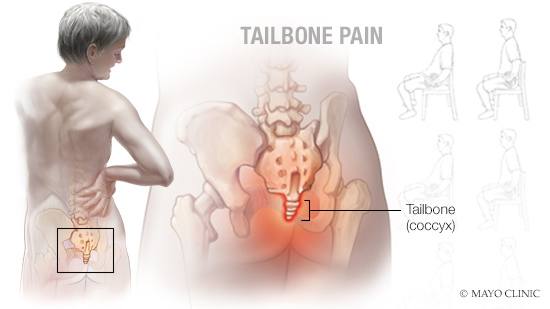-
Mayo Clinic Q and A: Tailbone pain often goes away without medical treatment

DEAR MAYO CLINIC: My tailbone has been hurting for the past few weeks. I have read that it takes a while to heal, but is there anything I can do in the meantime to lessen the pain? At what point would it be necessary to see my doctor?
ANSWER: Although tailbone pain can be uncomfortable, in most cases it will go away on its own within a few months. During that time, there are steps that you can take to lessen the pain. If your pain lasts for more than two months or if it gets worse despite self-care, make an appointment to see your health care provider about your concern.
Your tailbone, or coccyx, is the bony structure at the bottom of your spine that helps support your pelvic floor. Tailbone pain is a condition called “coccydynia.” Those with coccydynia usually experience dull, achy pain in or around the tailbone. This pain may become sharper or more intense after sitting or standing for a long time, during sex, or with urination or a bowel movement.
Numerous situations can result in tailbone pain. It is often the result of an injury due to a trauma during childbirth or a fall. Tailbone pain sometimes can arise after sitting on a hard surface for a long time, or sitting on an ill-fitting or jouncing seat. In some cases, the pain may be the result of sitting posture changes brought on by obesity or aging. Rarely, the cause of tailbone pain is something more serious, such as an infection, benign tumor or cancer.
Medical treatment typically is not needed for tailbone pain. But try this to lessen the pain while you’re seated: Sit completely upright, keeping your back firmly against the chair, your knees level with your hips, feet on the floor and shoulders relaxed. Although it is best to avoid sitting on hard surfaces, a heavily cushioned, overstuffed surface can allow you to sink into an unnatural, painful seating posture, which also isn’t ideal. Select a supportive chair with a moderate amount of cushioning.
If pain is not relieved by those changes, adjusting your weight by leaning forward slightly when seated may help. Sitting on a doughnut-shaped cushion or a V-shaped wedge cushion may help distribute weight away from the painful area. Using heat or ice on the painful area, as well as taking over-the-counter pain relievers, also may offer some relief.
Use these techniques until the pain subsides. In many cases, the pain will lessen and then disappear over the course of several weeks or several months. In only a minority of people does tailbone pain last beyond that length of time.
If tailbone pain persists for more than two months or if it gets worse despite these measures, see your health care provider for an evaluation to rule out other potential causes. For chronic tailbone pain, a consultation with a specialist in pain medicine or physical medicine and rehabilitation may be useful.
When necessary, treatment for chronic tailbone pain may include instruction in pelvic floor relaxation techniques; physical therapy; or manipulation of the coccyx, which is usually performed through the rectum. An anesthetic and corticosteroid injection may help some severe or persistent cases. These injections usually are performed by an anesthesiologist or other pain management expert. Given the potential for substantial complications, surgery is only considered as a last resort in severe cases. — Dr. David Bell, Community Internal Medicine, Mayo Clinic, Rochester, Minnesota
Related Articles







